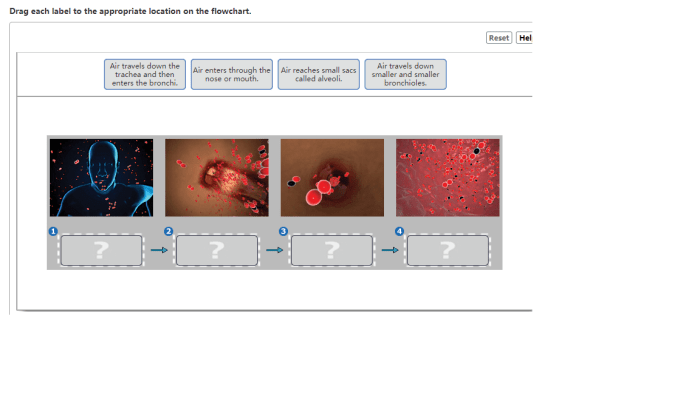Drag each label to the appropriate location on the flowchart. Embark on a journey into the realm of flowcharts, where clarity and efficiency reign supreme. This guide will illuminate the art of labeling flowcharts, empowering you to create visually stunning and informative diagrams that streamline communication and optimize processes.
Flowcharts are the visual language of process optimization, and labels play a pivotal role in their effectiveness. They provide context, clarity, and direction, guiding users through complex processes with ease. By mastering the placement and usage of labels, you can transform your flowcharts into powerful tools for problem-solving, communication, and decision-making.
Drag-and-Drop Functionality in Flowcharts
Drag-and-drop functionality allows users to modify a flowchart by dragging and dropping symbols or other elements from a palette onto the flowchart canvas. This functionality can be used to add, remove, or rearrange symbols, making it easier to create and modify flowcharts.
Benefits of Drag-and-Drop Functionality
- Increased efficiency: Drag-and-drop functionality can save time by allowing users to quickly add, remove, or rearrange symbols.
- Improved accuracy: Drag-and-drop functionality can help to reduce errors by allowing users to easily move symbols to the correct location.
- Enhanced collaboration: Drag-and-drop functionality can make it easier for multiple users to work on a flowchart simultaneously.
Limitations of Drag-and-Drop Functionality
- Potential for errors: Drag-and-drop functionality can also introduce errors if users accidentally drop symbols in the wrong location.
- Limited customization: Drag-and-drop functionality may not allow users to customize the appearance of symbols or other elements.
Flowchart Labels: Drag Each Label To The Appropriate Location On The Flowchart.

Labels are used to provide additional information about the symbols in a flowchart. There are several different types of labels, including:
- Process labelsdescribe the actions that are performed in a process step.
- Decision labelsdescribe the conditions that are used to make a decision.
- Input/output labelsdescribe the data that is input or output from a process step.
- Terminator labelsindicate the start or end of a flowchart.
Purpose of Labels
Labels serve several important purposes in a flowchart:
- Clarity: Labels can help to make a flowchart more clear and easy to understand.
- Accuracy: Labels can help to ensure that a flowchart is accurate by providing additional information about the symbols.
- Readability: Labels can help to make a flowchart more readable by breaking up the text into smaller chunks.
Label Placement

The placement of labels is important for the overall effectiveness of a flowchart. Labels should be placed in a way that makes them easy to read and understand. Here are some guidelines for placing labels:
- Proximity: Labels should be placed close to the symbols they describe.
- Alignment: Labels should be aligned with the symbols they describe.
- Visibility: Labels should be placed in a way that makes them easy to see.
- Consistency: Labels should be placed in a consistent manner throughout the flowchart.
Effective Label Placement
Effective label placement can help to make a flowchart more clear and easy to understand. For example, the following flowchart uses effective label placement to describe the process of making a cup of coffee:
[Insert flowchart image here]
Ineffective Label Placement, Drag each label to the appropriate location on the flowchart.
Ineffective label placement can make a flowchart difficult to read and understand. For example, the following flowchart uses ineffective label placement to describe the process of making a cup of coffee:
[Insert flowchart image here]
Flowchart Structure

Flowcharts have a basic structure that consists of the following elements:
- Start symbol: The start symbol indicates the beginning of the flowchart.
- Process symbols: Process symbols represent the actions that are performed in a flowchart.
- Decision symbols: Decision symbols represent the conditions that are used to make a decision.
- Input/output symbols: Input/output symbols represent the data that is input or output from a process step.
- Terminator symbol: The terminator symbol indicates the end of the flowchart.
Importance of Consistent Symbols
It is important to use consistent symbols throughout a flowchart. This will help to make the flowchart more clear and easy to understand. For example, the following flowchart uses consistent symbols to describe the process of making a cup of coffee:
[Insert flowchart image here]
Flowchart Applications

Flowcharts have a wide range of applications, including:
- Communication: Flowcharts can be used to communicate complex processes in a clear and concise way.
- Problem-solving: Flowcharts can be used to identify and solve problems.
- Process optimization: Flowcharts can be used to identify and eliminate inefficiencies in a process.
Real-World Examples
Flowcharts have been used successfully in a variety of real-world scenarios, including:
- Business process mapping: Flowcharts can be used to map out the steps in a business process.
- Software development: Flowcharts can be used to design and document software programs.
- Project management: Flowcharts can be used to plan and track projects.
Helpful Answers
What is the purpose of labels in a flowchart?
Labels provide context, clarity, and direction to users by describing the purpose and function of each step, decision, or action in a flowchart.
What are the different types of labels used in flowcharts?
Flowcharts use various types of labels, including process labels, decision labels, input/output labels, and annotation labels, each serving a specific purpose in enhancing the clarity and readability of the flowchart.
How can drag-and-drop functionality improve the usability of flowcharts?
Drag-and-drop functionality allows users to easily modify and rearrange flowchart elements, making it easier to create and update flowcharts, fostering collaboration and iterative process improvement.